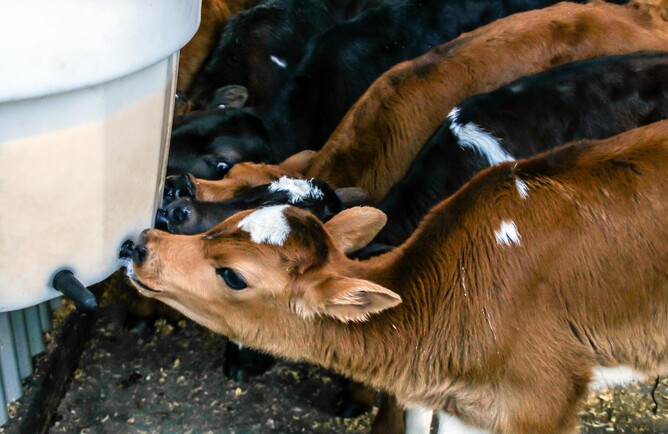The ultimate aim of calf rearing is to make the calf as strong and healthy as possible. Colostrum is key to this.
I’m sure you know that colostrum is the first milk a cow produces after calving, which is essential for building a calf’s immune system – but what about gold colostrum? It’s the very first colostrum that the cow creates and is rich in energy, proteins, and vital antibodies.
This is the best type of colostrum to get into your newborn calves. The more antibodies a calf receives, the stronger and healthier it will be.
There are four ‘Qs’ when it comes to feeding colostrum:
Quickly
The first 6-12 hours after birth are when the best absorption of antibodies happens. If a calf has to wait a whole day for that first drink of colostrum, then they won’t get enough antibodies, as the gut wall ‘closes’ after 24 hours and can’t absorb them. This leads to failure of passive transfer.
For this reason, we recommend twice daily pick-ups – the sooner you can collect them and ensure they receive that all important colostrum, the better.
Quantity
Each calf should get a minimum of 10% of their body weight in gold colostrum during their first 12 hours of life, e.g. 4L if the calf is 40kg.
If they won’t suckle, gently tube feed them to ensure they get what they need.
Quality
Before feeding newborn calves, test each batch of gold colostrum with a Brix refractometer. Calves under 24 hours old should receive colostrum that measures 22% or higher.
To get this quality, milk newly-calved cows as soon as possible, don’t mix this first milking colostrum in with other colostrum, and try to use gold colostrum the same day it is collected.
If your colostrum is measuring less than 22% or you don’t have enough high-quality colostrum for the number of calves that day, you need to feed more within their first 12 hours to ensure they get enough antibodies. You could also look at mixing in a product like Launchpad18 to enhance the antibody levels.
Qleanliness
Everybody knows that cleanliness around young animals is important, but wet weather and high workloads can make hygiene standards start to slip. It’s so crucial though that you maintain good colostrum management, as bacteria getting into the colostrum will quickly lower its quality and the amount of antibodies it contains.
Clean buckets, feeders, and other equipment with hot, soapy water after every use. Keep lids on buckets of colostrum closed. If you need to store colostrum longer than a day or two, add a preservative like potassium sorbate.
If these four ‘Qs’ aren’t achieved:
Failure of passive transfer (FPT)
The transfer of immunity via colostrum is often referred to as ‘passive transfer’. FPT is when a calf doesn’t ingest an appropriate amount of antibodies in the required timeframe. Perhaps they weren’t given enough colostrum quickly enough, maybe the colostrum was low-quality, or there may simply have been too much bacteria in it.
Insufficient antibodies leads to a weaker immune system and an increased risk of poor growth, disease and death. A calf will be twice as likely to get sick and twice as likely to die between 6-12 months old. If these calves become part of the herd, they may struggle to have good production levels or conception rates.
Total protein (TP)
We can check for FPT by analysing blood samples from calves. We look at the concentration of TP and this gives us an indication of whether they received enough gold colostrum at birth.
It’s an easy test that we do in-house, giving you results quickly. If the TP is low, the antibody levels of those calves can’t be changed, but there will hopefully be time for you to adjust your practices for the rest of spring.
Have a yarn with your KeyVet if you would like advice about colostrum and calf management, and let us know if you would like any TP sampling done on calves this year.

